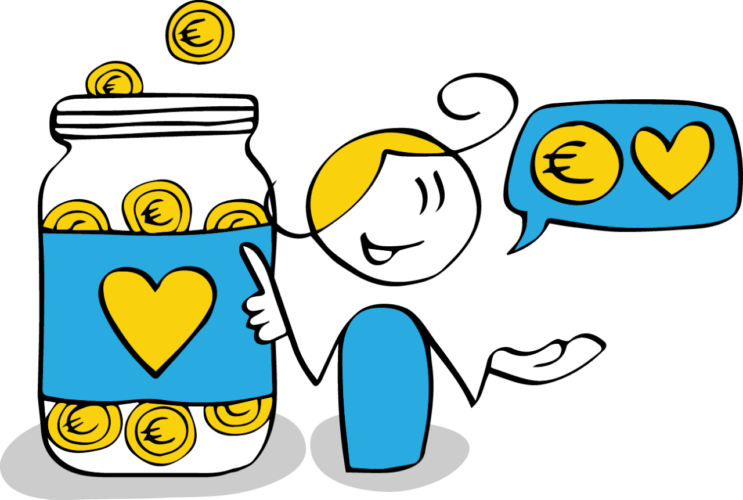
Fundraising
We live in a world where most of society uses money as a payment medium. That means we also need to raise our funds so we can perform our goals and visions – and it doesn’t really matter if we are profit or non-profit organisations.
I personally very much like a definition of one coLAB participant, who described fundraising as “making decisions which drive the direction of the organisation and seeking support for them”. By this “definition” it also doesn’t matter what kind of organisation we are talking about.
Of course, by fundraising, we are mostly talking about money – but if we go wider we can find this support for organisations in the resources, relationships, and colLABorations. This way being a community organiser sometimes means being a fundraiser. Starting by putting people together, building relationships, looking for the resources within the community and out of it – ending by collecting money for the community’s activities or/and the organisers fee – because, well, we all need some money to pay checks.
Steps of fundraising strategy
On the Internet / in the books, you may find dozens of approaches on how to create a fundraising strategy and fundraising campaign. For the purpose to make this process as universal as possible I define 5+1 steps you should go through if making your fundraising strategy (or a campaign).
WHY? MAP! PLAN! HOW? DO!
FIRST: Define your fundraising WHY
Why do you need to fundraise?
- What is the purpose of your fundraising?
- What is the need?
What is the situation in your organisation? … community? … team?
- Look at all the resources around you. (people, know-how, facilities, …)
(It might help you to go back to your situation analysis from ABCD community)
What are you fundraising for?
Define the “product” people are willing to pay for
-
- e.g. buying a t-shirt from Amnesty International means buying justice for unfairly imprisoned people and supporting human rights awareness raising
Find the message (the emotion) behind the “product”
-
- How does this “product” contribute to the world?
- What does your organisation/community bring to society?
- Why should people buy this product – why should they support your organisation/community?
SECOND: MAP the potential donors
Do you remember Mapping the Community?
If you have done this step of community organising you have saved a lot of work for yourself now. Part of the mapping the community could also be mapping the potential donors – the very first source for fundraising is the community itself and all the stakeholders or people involved in communities activities. This involvement can be even some emotional connection to the topic of community activities, activities of the organisation, or mission, and values of the organisation.
In your fundraising mapping you should also focus on the question:
Are you catching a lot of small fish or one whale?
Having a whale might save the whole community for a very long time, but have you ever pulled a whale out of the sea? It takes a lot of preparation, adaptation of your PLANs, and work to slice the whale.
Looking for one big donor (corporates, grants, …) might help for a while. Yet there is a question of independence – if someone gives you a lot of money they usually want to have some power in decision making – and values of the organisation and community.
Would you name your event or even organisation starting with ABSOLUT, if they pay you enough? This is how simple it could be. Maybe we could just name this Tool-box ABSOLUT coLAb and we wouldn’t have to worry about the money.
By the way, this community organising educational Tool-box is funded by the Visegrad Fund – so yes, sometimes it is nice to find a whale 🙂
Here are some questions to answer when you’re doing your mapping for fundraising strategy:
- Who are the potential donors?
- Where are they based?
- What’s their „criteria“?
- Why should they donate?
- How to contact them?
THIRD: PLAN your numbers
By planning your numbers I mean to define:
1. the Deadline
- Strategy is designed for months or years
- Campaign usually takes weeks or months
2. the Amount
- Amount of money (resources) you need to collect
- How much will it cost?
- What is the fee for people doing fundraising?
- How many people do you need for this?
- How much time will it take?
- What other resources will it cost and what amount?
This step is very much similar to setting up your SMART goals. The acronym SMART stands for:
- Specific – State what you will do; Use action words
- Measurable – Define a way to evaluate; Use metrics or data
- Achievable – Be realistic; Possible to accomplish
- Relevant – Makes sense for accomplishing your WHY
- Time-framed – Set up a deadline
FOURTH: Define HOW are you going to fundraise
After you decide if you are aiming for the big donations or individual donors, define the fundraising technique:
- Are you fundraising online, offline, or both?
- Is it going to be a one-time event or long-term activity?
Examples of one time events:
auctions & beneficial gatherings (concerts, theatre, movie screening, …), clothes swapping, festivals, food-based events, etc.
Examples of long-term activities:
membership fee, direct marketing techniques (call, email, mail, …), merchandise selling, etc..
One of the approaches could be to look for the activities your organisation is doing and think about how those activities could be transformed into “business products”. For example in Otvorená Hra we are focusing on trainings – thus we offer our services to the business and other organisations.
Who else is involved?
Once somebody makes a donation you have some kind of relationship with them. If they gave you some donation in the past – try to contact them and learn what was their motivation that time and try to “convert” them into “regular donors”. Regular donors and donors who gave you bigger amounts of money are usually somehow connected to the topic and/or values and mission of your organisation. That means they are the perfect candidates to become the ambassadors of your message and organisation. Ask them and welcome them on board – they would be no more just donors but a part (members) of some bigger idea you are all working on.
FIFTH: DO your fundraising!
After all that preparation there is a time for action!
If you are organising a fundraising event there are some things you should think about as well: How are you going to manage PR?
Is there any medium you can use? Television? Radio? Magazines?
Writing some online articles about the topic? Creating a video about the event?
What about the next steps? What would be a follow-up?
… and do not forget to “record” the moment for future actions 😉
The pictures and videos created from the event might be used as nice marketing material for future fundraising actions.
SIXTH: Check your WHY again. EVALUATE the process.
During all the time of your fundraising and after your actions – or after your deadline – check again your initial situation. Repeat the very first step and see – What changed?
- How (much) were your objectives fulfilled?
- How much did you raise?
- Who was part of the campaign?
- How did your campaign influence your organisation / community / actions?
- What would you do differently next time?
- What would you do exactly the same way?
- If some action didn’t work as planned – why? What happened?
The most important part of the final step: stay in touch with your donors!
Ask them what medium they prefer to communicate with: newsletters, anniversary (annual) meetings, letters, regular (annual) reports, Zoom calls, etc. … and implement it within your next action.
You can learn more about the steps of fundraising campaigns here.
To learn more about creating social change campaign (and fundraising campaign) I can highly recommend this Framing Equality Toolkit by ILGA Europe 2017
